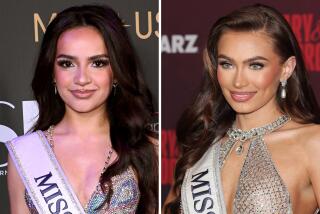Winning Ways : Pageant Pygmalions Are Reinforcing a Standard Look for Beauty Queens
- Share via
THE KINDS OF faces that are in demand for cover girls seem to change as quickly as fashions: Twiggy in the ‘60s, Cheryl Tiegs in the ‘70s; Elle Macpherson in the ‘80s. But the kind of beauty that wins pageants somehow stays constant.
Pageant producers describe it as an All-American look: fluffy hairdo, carefully shadowed eyelids, curvaceous body. That description, or parts of it, could apply to Mary Ann Mobley, Miss America of 1959, as much as to Gretchen Elizabeth Carlson, the present titleholder. Why is this the prevalent look? Perhaps curls and poufs are better suited to tiaras than other hairdos. But the real reason may be that consultants such as Richard Guy and Rex Holt have made a business of doing makeovers for pageant competitors.
The main activity of Guy and Holt, owners of GuyRex Associates of Beverly Hills and El Paso, is producing state and local pageants. GuyRex’s current high profile has resulted in part from its having coached the past four Miss U.S.A. winners: Laura Martinez-Herring in 1985; Christy Fichtner in 1986; Michelle Royer in 1987 and Courtney Gibbs in 1988. GuyRex has focused its consultant efforts solely on the Miss U.S.A. contest and has not worked with contestants in any other national pageants. Other consulting firms -- have been called upon by participants in other contests, but GuyRex claims the best track record to date.
Critics say that such consultants are creating beauty queens who all look alike. But the team maintains that the key to its success is avoiding the cookie-cutter mentality. They often cite the differences between 5-foot-6 brunette Martinez-Herring and Fichtner, a tall blonde. Yet these women and many other clients have a similar, contest-winning look.
Holt describes the look as a typical girl next door who may not have been born perfect but who makes the most of her individuality. “We’re looking for a real, touchable girl--the girl whom John Q. Public can relate to,” Holt says. High-fashion-model types are not approachable, he says. Even when the skin-and-bones look was de rigueur for all models, pageant aesthetics called for a fit, not skinny, figure. The overall look, Holt says, is “simple to achieve, literally back to basics.”
Christina Faust, the current Miss California-U.S.A., who will compete in the 1989 Miss U.S.A. contest, says she was not a girl-next-door type before she put her image in the hands of Guy and Holt. They determined that her harshly bleached tresses made her face look “faded.” When she competes in February in Mobile, Ala., Faust will wear her natural, dirty-blond color, enhanced subtly with highlighting.
Guy and Holt believe that eye makeup should be in grays, beiges and earth tones and not, Holt says, “that big hunk of blue” over the eyes. Hair should be loose, long and fluffy, though Guy concedes that someday he may approve of a pixie-short cut. “We may get a girl who needs short hair because long hair will take away from her face, and I won’t object.”
He adds that the GuyRex standards have evolved in the 13 years they’ve had their own company, which they are in the process of franchising. They also plan to open a modeling and self-development school in El Paso. “We’ve tried every kind of look,” Holt says. “but we learned. Everybody has an idea from magazines and movies that they have to emulate someone else--that’s a big mistake.”
Hair and makeup: Jayson Jefferys / A La Mode






